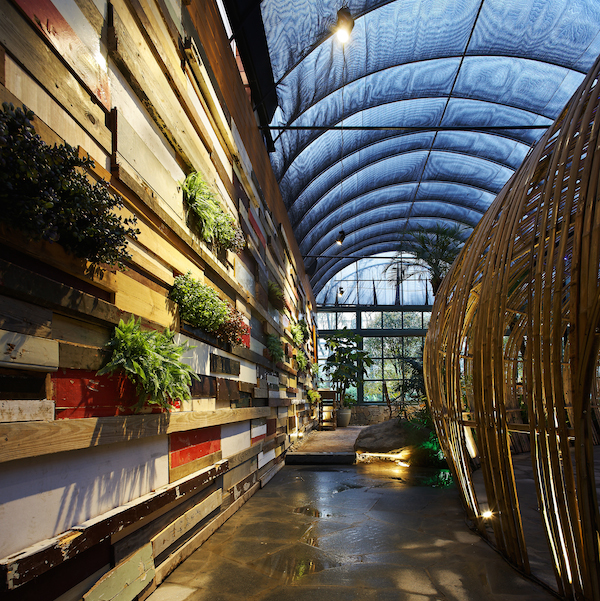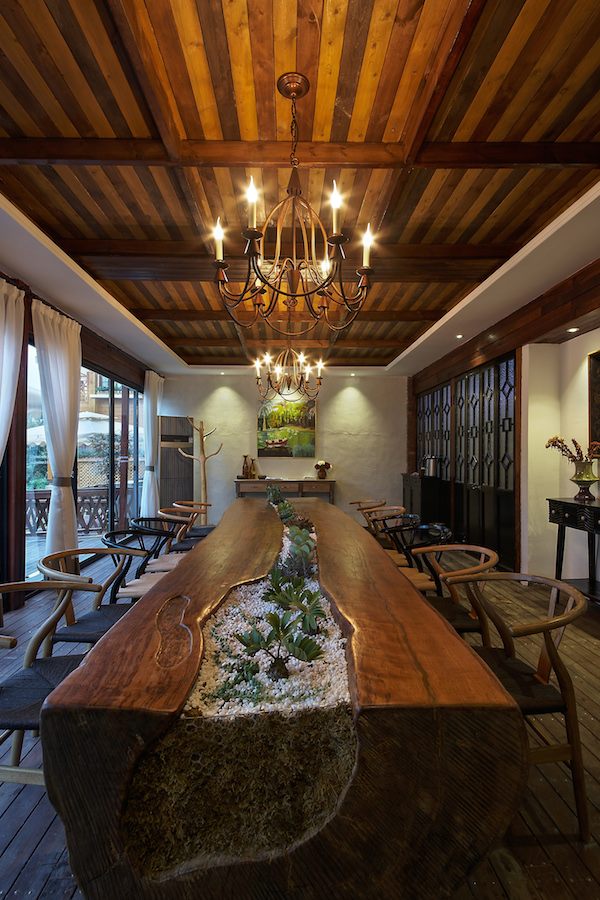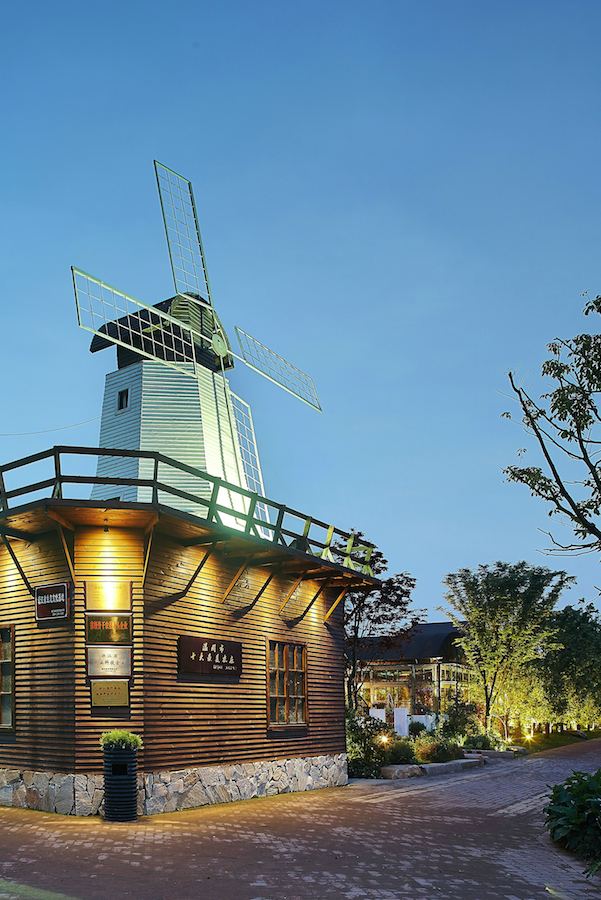With the Golden Pin Design Award 2015 around the corner, Tamsin Bradshaw speaks to Zhejiang Vision Decoration Engineering Co., Ltd about receiving a Design Mark in the lead-up to the main event.

December 7th, 2015
The Golden Pin Design Award is just a few days away, with the awards ceremony and forum set for 10 December 2015. Held in Taipei, the award celebrates design created for and within huaren, or Chinese-speaking, communities.
In the lead-up to the big day, Golden Pin has announced various Design Mark recipients, who go in the running for the bigger design awards. Meet Vanilla is one of them – a restaurant that’s all about connecting people and nature through herbs, vegetables and gardens. This original space embraces the passage of time: as nature takes its course, plants will be able to grow and find their own paths. Here, Wang Yi, Designer at Zhejiang Vision Decoration Engineering Co., Ltd, tells us about the project.
 Plants line the walls inside Meet Vanilla
Plants line the walls inside Meet Vanilla
How does your design connect with the needs of huaren consumers?
In Chinese spirituality, heaven is a reflection of real life, and, even now, people strive to bring heaven and humanity closer together by combining humanity with nature. A restaurant itself cannot provide such spirituality, but it can allow people and plants to coexist harmoniously.
What inspired the design for Meet Vanilla?
“Allowing people to feel the passage of time together with plants and space” is the direct, sincere and natural attitude Meet Vanilla hopes to demonstrate to its customers. The inspiration for this project came from sunlight, water, bamboo, nature and other key elements of life.
Why is the connection between humans and nature so important?
The connection between humans and nature comes from humans naturally needing to depend on nature. While humans develop, we must develop in cooperation with nature, using our knowledge to create better surroundings. The Meet Vanilla project uses only its own green produce, in keeping with its responsibility to the surrounding community, and taking the protection of the environment, the conservation of resources, and reduction of emissions as its mission.
 Herbs and plants have even been incorporated into table design at Meet Vanilla
Herbs and plants have even been incorporated into table design at Meet Vanilla
What kinds of herbs have you planted at this restaurant?
In addition to the decorative plants needed for the spatial modeling, Meet Vanilla also features a great variety of edible plants. For example, plants such as mint, rosemary, basil, and lavender have a fundamental impact on the scent and sight of a visitor to Meet Vanilla.
Tell us about the interiors. How does the design harmonise with the plants?
For the interior design, choosing the right materials was rather troublesome, as modern materials, without embellishments, are difficult to coordinate with all of the surrounding plants. Our indoor environment also needed to be more humid, and we needed to let more ultra-violet rays in than the average indoor space, but not many synthetic materials can last for a long time.
For Meet Vanilla, we essentially used recycled materials, or natural materials from our surroundings. For example, local clay with rice straw stamped down onto it was used to make our retaining wall; local stone and old bricks were used to make our floor; local bamboo was woven together to make the principal part of our structure; multi-colored recycled wood was mounted on the wall as a veneer; and granitic plaster was stacked to create flowerpots, dividing walls, and other features. These simple, rustic materials give the indoor space a feeling of natural strength, with the additional result of complementing the indoor plants and space.
Most notable amongst these materials is bamboo, a material that Chinese people have a deep affection for. Bamboo is an excellent material for constructing the main part of the internal structure. Bamboo is an extremely strong material; as long as it is well crafted and the appropriate rot-preventing measures are taken, its durability, workability, and flexibility are all qualities that make it easy to shape.
 “Meet Vanilla’s original structure was a simple farmer’s pavilion,” says Wang.
“Meet Vanilla’s original structure was a simple farmer’s pavilion,” says Wang.
What is the significance, for you, of the Golden Pin Design Awards? What does it mean to receive a Design Mark in Spatial Design?
To me, being fortunate enough to receive a 2015 Design Mark in Taiwan’s prestigious Golden Pin Design Award is a great honour and it serves to strengthen my innermost convictions. It also makes me happy because at the same time, it validates the appreciation that I have received from so many people who tell me the Meet Vanilla project is so wonderful.
How did Zhejiang Vision Decoration Engineering Co., Ltd and Yongjia Weald Fields Landscape Engineering Co., Ltd collaborate on this project?
The Meet Vanilla project is different from traditional design projects; from the concept proposal to its completion, we had the complete support and trust of the client, and we strove to honor the work of traditional craftsmen. Working with a low budget and still being able to make an innovative new project embodies the values and approaches shared by both Zhejiang Vision Decoration Engineering Co., Ltd and Yongjia Weald Fields Landscape Engineering Co., Ltd. Green, environmentally friendly projects embody Zhejiang Vision Decoration Engineering Co., Ltd’s core value: “Be a business that benefits the community.” These shared values ensured our collaboration went smoothly and was enjoyable.
Golden Pin Design Award
goldenpin.org.tw
INDESIGN is on instagram
Follow @indesignlive
A searchable and comprehensive guide for specifying leading products and their suppliers
Keep up to date with the latest and greatest from our industry BFF's!

BLANCOCULINA-S II Sensor promotes water efficiency and reduces waste, representing a leap forward in faucet technology.

In this candid interview, the culinary mastermind behind Singapore’s Nouri and Appetite talks about food as an act of human connection that transcends borders and accolades, the crucial role of technology in preserving its unifying power, and finding a kindred spirit in Gaggenau’s reverence for tradition and relentless pursuit of innovation.

Within the intimate confines of compact living, where space is at a premium, efficiency is critical and dining out often trumps home cooking, Gaggenau’s 400 Series Culinary Drawer proves that limited space can, in fact, unlock unlimited culinary possibilities.

To honour Chef James Won’s appointment as Gaggenau’s first Malaysian Culinary Partner, we asked the gastronomic luminaire about parallels between Gaggenau’s ethos and his own practice, his multidimensional vision of Modern Malaysian – and how his early experiences of KFC’s accessible, bold flavours influenced his concept of fine dining.
The internet never sleeps! Here's the stuff you might have missed

Traversing space, time and convention, &Tradition’s imaginative new collection yields a dynamic, intricate and profoundly relevant design narrative introducing new vocabulary to the Danish design house’s lexicon.

The first quarter of 2025 heralded a period of growth and transformation in architecture and design, with practices broadening their influence, experiencing leadership shifts and inaugurating new operations – here’s what you need to know.